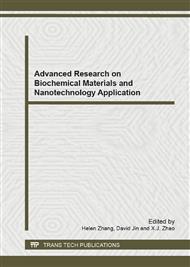p.76
p.83
p.87
p.92
p.96
p.100
p.104
p.108
p.116
Electrochemical Properties of LiFePO4/C Composite by Spray-Drying Method
Abstract:
LiFePO4/C composite cathode materials were synthesized by spray-drying method using LiH2PO4 and Fe2O3 as raw materials and amylum as conductive additive and reducing agent. The microstructure of the samples was characterized by X-ray diffraction; charge/discharge cycling performance and electrochemical impedance spectroscopy (EIS) were used to characterize their electrochemical properties. X-ray diffraction result showed that LiFePO4/C composite has an order olivine structure with space group of Pnma. The charge/discharge tests showed that the cathode material has a high discharge capacity of 140.8mAh/g after 5 cycles at 0.1C rate. And after 100 cycles at 1C rate, the discharge capacity is 108.4mAh/g.
Info:
Periodical:
Pages:
96-99
Citation:
Online since:
January 2013
Authors:
Price:
Сopyright:
© 2013 Trans Tech Publications Ltd. All Rights Reserved
Share:
Citation:


